Smart Diaper Market Size
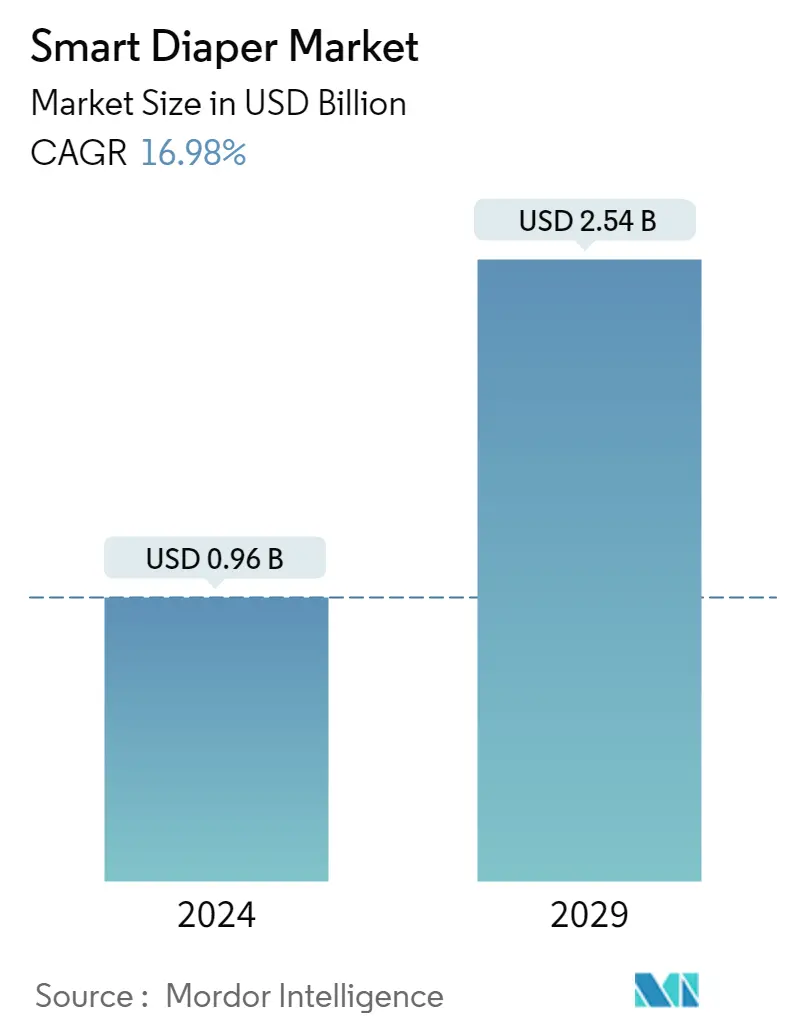
| Study Period | 2019 - 2029 |
| Market Size (2024) | USD 0.96 Billion |
| Market Size (2029) | USD 2.54 Billion |
| CAGR (2024 - 2029) | 16.98 % |
| Fastest Growing Market | Asia-Pacific |
| Largest Market | North America |
Major Players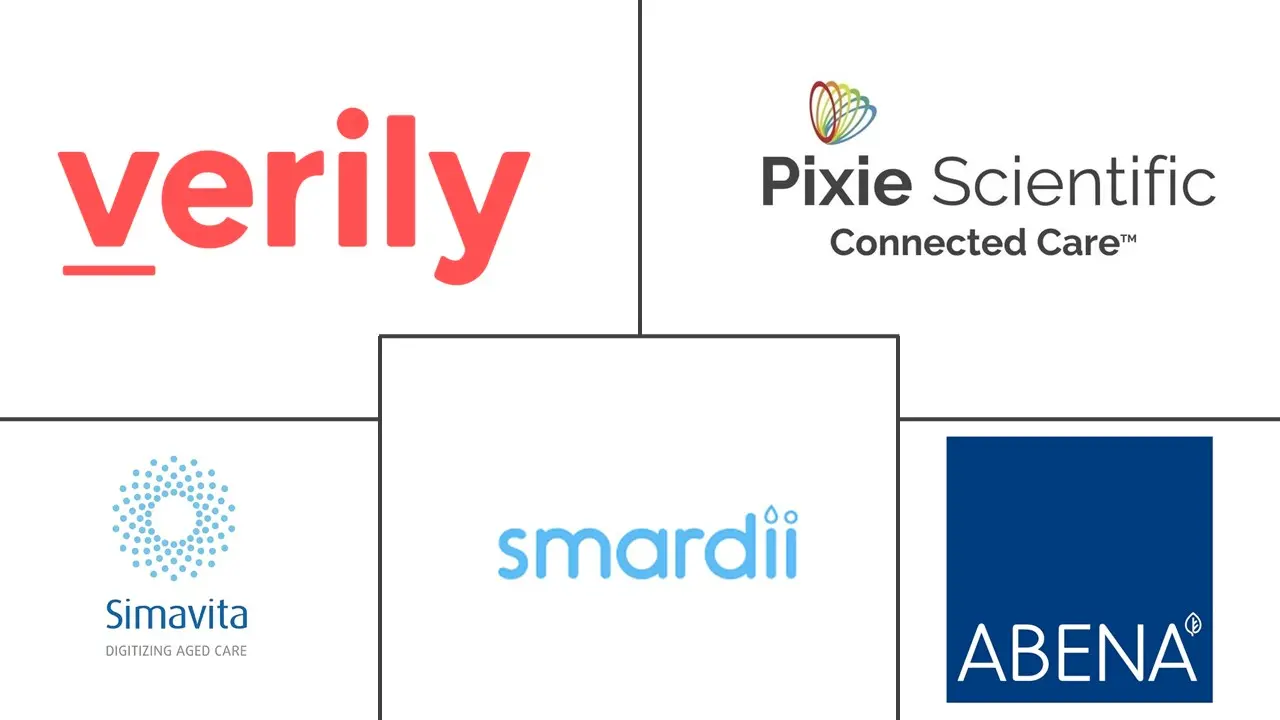
*Disclaimer: Major Players sorted in no particular order |
Smart Diaper Market Analysis
The Smart Diaper Market size is estimated at USD 0.96 billion in 2024, and is expected to reach USD 2.54 billion by 2029, growing at a CAGR of 16.98% during the forecast period (2024-2029).
The global market is propelled by the growing utilization of technology to aid nuclear and working families in regard to childcare.
- A smart diaper is a form of undergarment that provides individuals with alerts regarding the need for a diaper change or if it becomes wet. The system of a smart diaper consists of sensors that are connected to mobile applications. Once a sensor detects a leak promptly identifies and activates an alarm. The market for smart diapers is expanding due to the rise in disposable incomes, the aging population in affluent countries, and the growing population in emerging nations. Furthermore, this innovation is considered one of the most remarkable advancements in continence care. It is expected that the increased utilization of smart diapers in hospitals, clinics, and nursing homes will contribute to the growth of the smart diaper market.
- A smart diaper is an advantageous undergarment equipped with an RFID sensor that notifies parents when it is necessary to change the baby. However, in the case of a soiled diaper, equivalent to two wet diapers, immediate action is required to prevent skin irritation and discomfort for the baby. Smart diapers serve as a means to assist parents in averting potential skin irritations and associated issues caused by prolonged diaper usage, ensuring the baby's well-being.
- The expanding senior population will likely influence the anticipated market growth in the forthcoming years. As families search for inventive approaches to baby care and with the rise in the elderly population, the demand for smart diapers equipped with advanced features and functionalities is projected to escalate, thereby propelling the overall market growth in the global smart diapers market.
- The primary product categories within the smart diaper industry encompass both infant and adult diapers. Adult diapers are specifically designed to assist elderly individuals who experience daily challenges such as dementia, urinary or fecal incontinence, diarrhea, or limited mobility. In addition to facilitating effective care, smart diapers have the potential to aid in the early detection of health conditions, including constipation, skin irritations, allergies, and incontinence.
- The market's growth is hindered by two main obstacles: insufficient consumer product knowledge and the exorbitant cost of smart-connected diapers in comparison to conventional ones. Moreover, smart diapers designed for adults present specific drawbacks such as prolonged dehydration, recurrent urinary tract infections, and the potential development of renal issues.
- The COVID-19 pandemic outbreak affected the market positively. The effect of the outbreak led to the breakup of the childcare business, which was outsourced to many agencies and professional childcare providers. Though various platforms tried to provide properly screened caregivers, the threat of the pandemic forced parents to get involved in baby care directly. This was expected to impact the market positively.
Smart Diaper Market Trends
The Rising Baby Care Will Act as a Major Driver of the Market
- The well-being of infants is of utmost importance and requires diligent attention. Consequently, numerous corporations employ advanced technologies like Alert Plus in smart diapers. An example of such innovation is the Smart Pee sensor, which incorporates a unique algorithm to provide timely information on temperature and humidity levels. These diaper technologies enable the creation of statistical data through applications, facilitating the tracking of diaper usage and bowel activity and issuing alerts when a diaper change is necessary.
- The market for smart diapers is experiencing growth due to increasing birth rates in both developed and developing nations and the growing prevalence of Internet usage. Furthermore, the rise of IoT devices and heightened consumer demand for smart connected products are expected to drive market expansion further. Additionally, the potential for smart diapers to monitor urine incontinence and diaper moisture levels to prevent skin ailments presents an attractive opportunity for market growth.
- The demand for smart diapers for infants is witnessing substantial growth owing to the escalating demand for baby care products and the expanding global population of newborns. The market is witnessing the emergence of various opportunities and trends that can prove advantageous for manufacturers and retailers of baby diapers. These manufacturers are investing in advanced technologies to create diapers of superior quality, offering improved absorbency, comfort, and flexibility, thereby catering to the requirements of discerning consumers. For instance, In 2022, India recorded the highest number of births, with 23 million, as per WorldMapper. China followed with 10 million, while Nigeria, Pakistan, and Indonesia registered 8 million, 6.4 million, and 4.5 million births respectively.
- Furthermore, smart diapers are beneficial for infants as they aid in preventing skin rashes and allergies on their delicate skin. Additionally, this system assists mothers and caregivers in identifying excretion patterns and training infants in natural processes at an early stage. Smart diapers prevent wetness and spoilage and monitor sleeping and breathing patterns. Manufacturers are currently developing fluffless diapers that absorb excess liquids.
- The e-commerce channel has emerged as a crucial distribution avenue for baby diaper products, propelled by the increasing prevalence of smartphones and internet access. The convenience and simplicity of online shopping have led consumers to increasingly opt to purchase baby diapers through this platform, giving manufacturers an opportunity to enhance their online visibility.
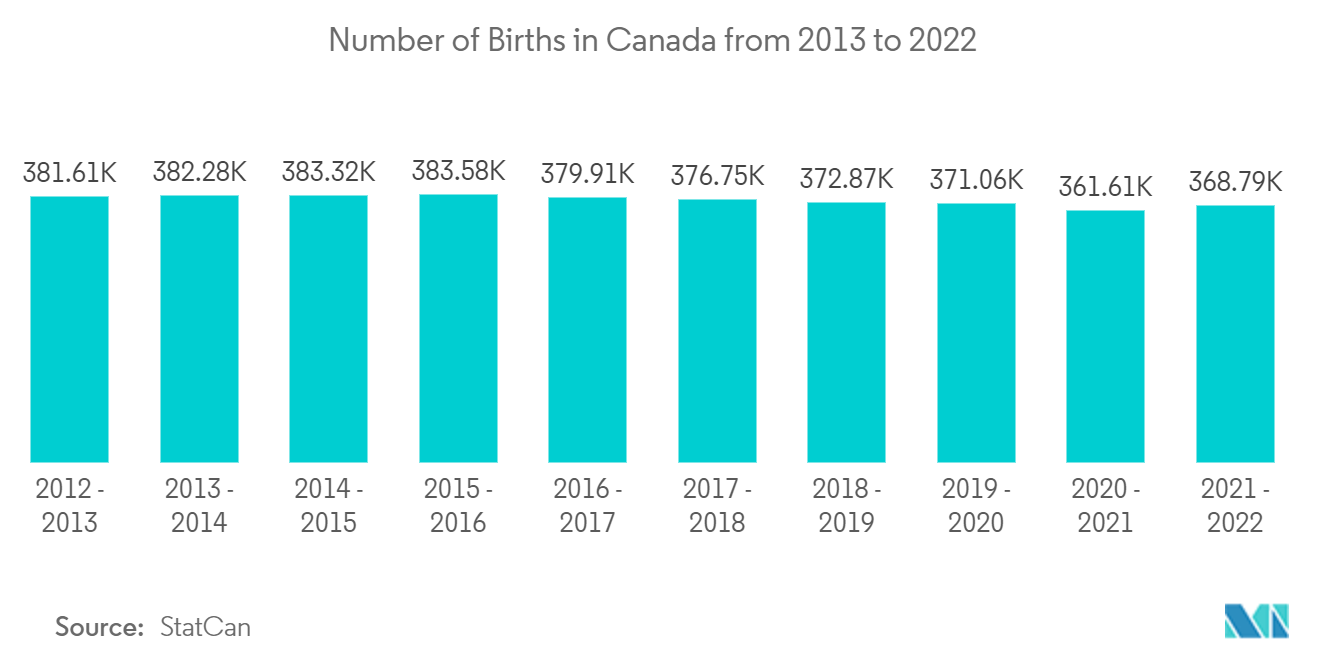
Asia-Pacific is Expected to be the Fastest Growing Market
- The Asia Pacific region is projected to experience the most rapid growth rate during the forecasted period. The market in the region is being propelled by the emergence of numerous startups developing new sensor technologies. The primary drivers of the market are the growing population and the prevalence of nuclear families in the region. Taiwan, Korea, and Australia are identified as emerging markets for this product. Furthermore, the increasing adoption of advanced care technologies for infants, adults, and the elderly is expected to drive significant demand in the Asia-Pacific region.
- Over 50 percent of the global population is comprised of individuals residing in Asia, a region projected to have the highest urban population by 2050. With India and China being the most populous countries in the world, Asia is anticipated to present significant market opportunities, particularly in the forecasted period, due to the addition of a substantial number of infants. For instance, the International Monetary Fund predicts that India's population will reach approximately 1,406.63 million by 2022, with further growth expected in subsequent years. Consequently, the rising population in the region will drive an increased demand for smart diapers.
- Prominent nations within the Asia-Pacific region, such as Japan, China, India, and South Korea, have successfully curtailed infant mortality rates owing to population expansion and the advancement of healthcare standards. Moreover, the demographic shift from rural to urban localities propelled the demand for intelligent diapers in Asia-Pacific countries. Notably, China's infant mortality rate has declined from 5.4 per 1,000 in 2020 to 5 per 1,000 in 2021, as the State Council Commission reported, and is projected to continue decreasing in the foreseeable future.
- According to the Hindawi Publishing Corporation, eco-diapers designed for infants aged 24 months and below are extensively utilized in India and China, with the Philippines and Japan following suit. By incorporating conductive yarns and sensors, these diapers can effectively detect moisture levels, triggering an alarm when significant moisture is detected.
- The market development potential in the region is significant due to the substantial proportion of elderly residents. Prominent nations in the Asia-Pacific region, such as Japan, China, India, and South Korea, have witnessed a rise in the aging population and improved healthcare standards. Additionally, the smart diaper market is experiencing a growing trend of technological advancements, particularly in the form of wireless or Bluetooth-enabled moisture sensors attached to the diaper's exterior. These sensors are supported by durable batteries that enable long-range internet connectivity. Furthermore, as stated in the Report of the Technical Group on Population Projections for India and States 2011-2036, the elderly population in India is projected to reach approximately 138 million individuals in 2021, comprising 67 million males and 71 million females. This number is anticipated to increase by approximately 56 million individuals by 2031. Similarly, the Chinese government reports that China's population of 1.44 billion is experiencing rapid aging. Individuals aged 65 years and older currently comprise 12.0 percent (173 million) of the people, which is expected to rise to 26.1 percent (366 million) by 2050.
- The increasing geriatric population is anticipated to make a substantial contribution to market demand. The market is expected to be driven by nursing homes, healthcare institutions, and clinics catering to elderly patients during the forecast period. Additionally, WHO data reveals that by 2025, 18 percent of Asia's population will be aged 65 or older, representing an 11 percent increase from 2010 levels. This trend is expected to create significant opportunities for the market, particularly as families become more nuclear in the region, resulting in a demand for smart diapers.
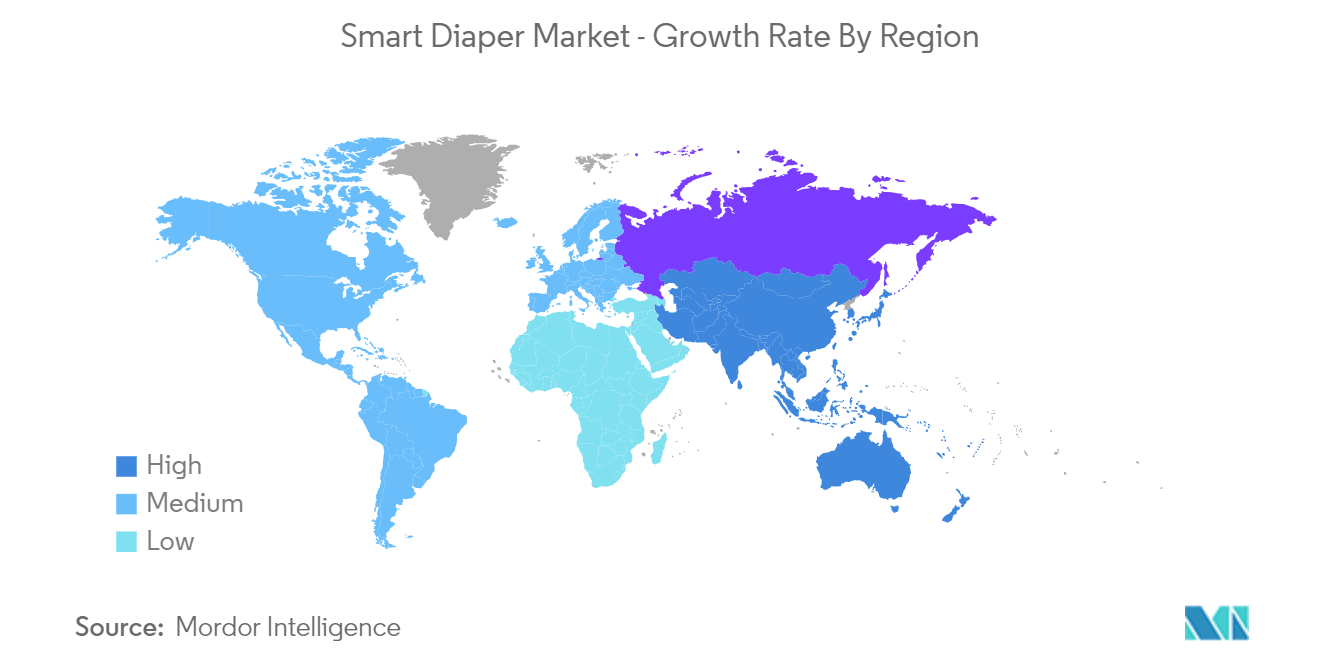
Smart Diaper Industry Overview
The studied market is semi - consolidated. The market has been experiencing a number of product launches and innovations to meet evolving consumer demands.
In February 2023, Researchers at Penn State University developed a technologically advanced diaper known as a smart diaper, which incorporates a sensor that sends an alert to a mobile device when it becomes wet. The diaper is constructed from pre-treated paper infused with sodium chloride and features a circuit board outline traced with graphite and a small lithium battery. Upon contact with liquid, the graphite reacts with the sodium chloride, causing electrons to flow and activating the sensor.
Smart Diaper Market Leaders
-
Pixie Scientific
-
Simavita Limited
-
Abena Holding A/S
-
Verily Life Sciences (Alphabet Inc.)
-
Smardii
*Disclaimer: Major Players sorted in no particular order
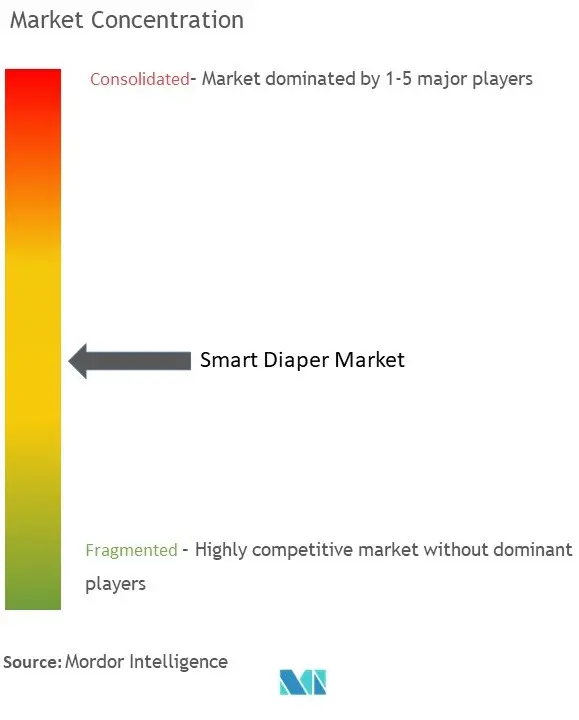
Smart Diaper Market News
- March 2023 - An innovative smart diaper has been created by an international team of scientists, with funding from the National Institutes of Health (NIH) and the National Science Foundation (NSF). Developed at Penn State, this diaper utilizes a basic pencil-on-paper design, incorporating an electrode sensor array treated with a sodium chloride solution. This array can detect dampness caused by urine. The simplicity and affordability of this sensor array could potentially pave the way for wearable, self-powered health monitors. These monitors could be used not only in smart diapers but also to predict serious health issues such as cardiac arrest and pneumonia.
- January 2023 - Chillax introduced its latest solutions at the Consumer Electronics Show (CES). Giraffe AI is an advanced baby monitor that incorporates artificial intelligence (AI) to send notifications whenever a baby is in danger. A smart AI-powered baby monitor with multispectral imaging, Thermo AI detects a baby's face and sleep posture while detecting body core temperature. The system also delivers notifications when there is a substantial temperature change in the diaper area.
Smart Diaper Market Report - Table of Contents
1. INTRODUCTION
- 1.1 Study Assumptions and Market Definition
- 1.2 Scope of the Study
2. RESEARCH METHODOLOGY
3. EXECUTIVE SUMMARY
4. MARKET INSIGHTS
- 4.1 Market Overview
-
4.2 Industry Attractiveness - Porter's Five Forces Analysis
- 4.2.1 Bargaining Power of Buyers/Consumers
- 4.2.2 Bargaining Power of Suppliers
- 4.2.3 Threat of New Entrants
- 4.2.4 Threat of Substitute Products
- 4.2.5 Intensity of Competitive Rivalry
- 4.3 Assessment of Impact of COVID-19 on the Industry
5. MARKET DYNAMICS
-
5.1 Market Drivers
- 5.1.1 Large Geriatric Population in Developed Countries
- 5.1.2 High Birth Rates and Rise in Disposable Incomes in Emerging Markets
-
5.2 Market Restraints
- 5.2.1 Infections and Kidney Problems Associated with their Prolonged Use might Act as a Restraint for Market Growth
6. MARKET SEGMENTATION
-
6.1 End-User Industry
- 6.1.1 Baby
- 6.1.2 Adult
-
6.2 Geography
- 6.2.1 North America
- 6.2.2 Europe
- 6.2.3 Asia-Pacific
- 6.2.4 Rest of the World
7. COMPETITIVE LANDSCAPE
-
7.1 Company Profiles
- 7.1.1 Smardii
- 7.1.2 Pixie Scientific
- 7.1.3 Simavita Limited
- 7.1.4 Abena Holding A/S
- 7.1.5 Verily Life Sciences (Alphabet Inc.)
- 7.1.6 Monit Corp.
- 7.1.7 Sinopulsar Technology Inc.
- 7.1.8 Hunan Cosom Care Products Co., Ltd.
- *List Not Exhaustive
8. INVESTMENT ANALYSIS
9. MARKET OPPORTUNITIES AND FUTURE TRENDS
** Subject To AvailablitySmart Diaper Industry Segmentation
Smart diapers are diapers integrated with sensors that enable effective care for babies and the elderly. Smart diapers are equipped with sensors that are connected to mobile applications that send out alerts as soon as they detect any leak.
The smart diaper market has been segmented by end users (baby and adult) and geography (North America, Europe, Asia-Pacific and Rest of the World). The market sizes and forecasts are provided in terms of value (USD) for all the above segments.
| End-User Industry | Baby |
| Adult | |
| Geography | North America |
| Europe | |
| Asia-Pacific | |
| Rest of the World |
Smart Diaper Market Research FAQs
How big is the Smart Diaper Market?
The Smart Diaper Market size is expected to reach USD 0.96 billion in 2024 and grow at a CAGR of 16.98% to reach USD 2.54 billion by 2029.
What is the current Smart Diaper Market size?
In 2024, the Smart Diaper Market size is expected to reach USD 0.96 billion.
Who are the key players in Smart Diaper Market?
Pixie Scientific, Simavita Limited, Abena Holding A/S, Verily Life Sciences (Alphabet Inc.) and Smardii are the major companies operating in the Smart Diaper Market.
Which is the fastest growing region in Smart Diaper Market?
Asia-Pacific is estimated to grow at the highest CAGR over the forecast period (2024-2029).
Which region has the biggest share in Smart Diaper Market?
In 2024, the North America accounts for the largest market share in Smart Diaper Market.
What years does this Smart Diaper Market cover, and what was the market size in 2023?
In 2023, the Smart Diaper Market size was estimated at USD 0.82 billion. The report covers the Smart Diaper Market historical market size for years: 2019, 2020, 2021, 2022 and 2023. The report also forecasts the Smart Diaper Market size for years: 2024, 2025, 2026, 2027, 2028 and 2029.
Smart Diaper Industry Report
Statistics for the 2023 Smart Diaper market share, size and revenue growth rate, created by Mordor Intelligence™ Industry Reports. Smart Diaper analysis includes a market forecast outlook to 2029 and historical overview. Get a sample of this industry analysis as a free report PDF download.



